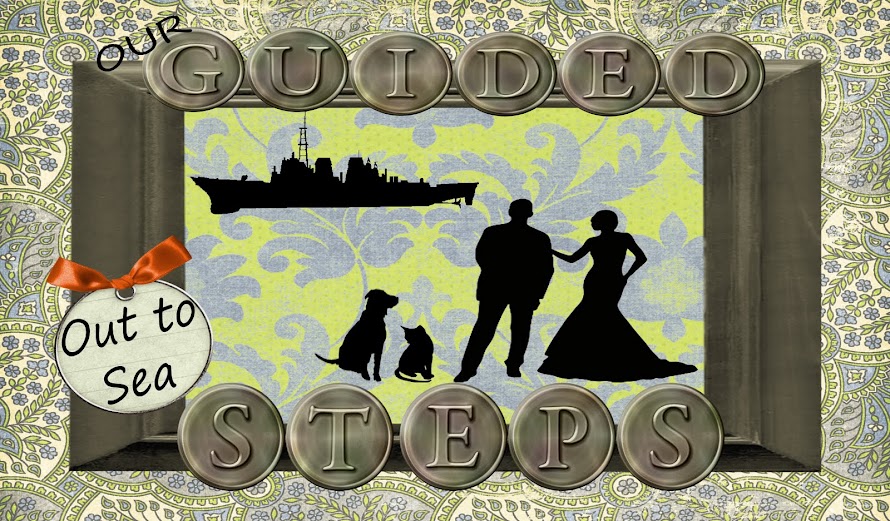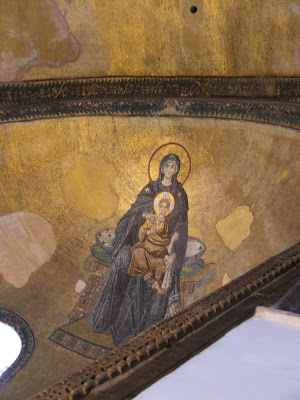It amazes me that 2 emblems of very different faiths sit directly across from each other.... and relatively safe. The Agia Sophia and the Blue Mosque. We started with the Christian side.

The “church of holy wisdom” is among the world’s greatest architectural achievements. The supreme church of Byzantium time period is over 1400 years old. It was the largest cathedral in the world for nearly a thousand years.
The Hagia Sophia had been a church for 916 years, a mosque for 481 years and since 1934, a museum.

The Hagia Sofia had its beginnings in a humble looking wooden roofed basilica way back in 390 A.D. The church was dedicated to Hagia Sophia or the Divine Wisdom. The church, then known as Megale Ecclesia or The Great Church, was burnt and reduced to rubble in 404 A.D.

The Hagia Sofia had its beginnings in a humble looking wooden roofed basilica way back in 390 A.D. The church was dedicated to Hagia Sophia or the Divine Wisdom. The church, then known as Megale Ecclesia or The Great Church, was burnt and reduced to rubble in 404 A.D.
At its site, Theodosius built an even bigger church. This building was again destroyed in the Nika Revolt of 532 A.D against Emperor Justinian. Under his orders, and supervised by architects Anthemius of Tralles and Isidorus of Miletus, the Hagia Sophia began to be rebuilt in that year itself. The Fourth Crusade of 1204 saw the plunder of the Hagia Sophia. The iconoclastic crusaders systematically eradicated all images with religious connotations from the Hagia Sophia.

1453 was a watershed year in the already battered history of Hagia Sophia. Sultan Mehmet, after winning over Constantinople, in the year 1453, ordered the Hagia Sophia to be turned into a mosque.

1453 was a watershed year in the already battered history of Hagia Sophia. Sultan Mehmet, after winning over Constantinople, in the year 1453, ordered the Hagia Sophia to be turned into a mosque.
Minarets, from which the summon cries for the daily prayers are issued; the Mihrab, an alcove in the wall facing Mecca and the member, which is a platform for the rendering of sermons, were the typically Islamic additions to the Hagia Sophia.



During the Sack of Constantinople in 1204, the Latin Crusaders vandalized valuable items in every important Byzantine structure of the city, including the golden mosaics of the Hagia Sophia. Many of these items were shipped to Venice. Following the building's conversion into a mosque in 1453, many of its mosaics were covered with plaster, due to Islam's ban on representational imagery.

Here is the marker for Henry Dandolo.... Remembered for his blindness, piety, longevity, and shrewdness, he is infamous for his role in the Fourth Crusade which he, at age ninety, directed against the Byzantine Empire, sacking Constantinople.


In the 16th century the sultan brought back two colossal candles from his conquest of Hungary. They were placed on both sides of the mihrab.


Seriously.... that is a really big candle stick. I wonder if it comes in citronella?

During the Sack of Constantinople in 1204, the Latin Crusaders vandalized valuable items in every important Byzantine structure of the city, including the golden mosaics of the Hagia Sophia. Many of these items were shipped to Venice. Following the building's conversion into a mosque in 1453, many of its mosaics were covered with plaster, due to Islam's ban on representational imagery.
The Synodical Letter
"To the right honourable lords our right reverend brethren and colleagues, Damasus, Ambrosius, Britton, Valerianus, Ascholius, Anemius, Basilius and the rest of the holy bishops assembled in the great city of Rome, the holy synod of the orthodox bishops assembled at the great city of Constantinople sends greeting in the Lord."
The Synod of Constantinople (A.D. 382).... The marble door.... It was used by the participants in synods, they entered and left the meeting chamber through this door.. And Harry wanted his picture taken there, but people kept getting in the way.... we stood there forever trying to find the perfect shot.

Here is the marker for Henry Dandolo.... Remembered for his blindness, piety, longevity, and shrewdness, he is infamous for his role in the Fourth Crusade which he, at age ninety, directed against the Byzantine Empire, sacking Constantinople.

The Deësis mosaic. In this panel the Virgin Mary and John the Baptist, both shown in three-quarters profile, are imploring the intercession of Christ for humanity on Judgment Day. The bottom part of this mosaic is badly deteriorated.

The Comnenus mosaic. Mary is standing in the middle, depicted, as usual in Byzantine art, in a dark blue gown. She holds Christ on her lap. He gives His blessing with His right hand while holding a scroll in His left hand.

Virgin and Child mosaic. This mosaic is situated in a high location on the half dome of the apse. Mary is sitting on a throne without a back, holding the Child Jesus on her lap. Her feet rest on a pedestal. Both the pedestal and the throne are adorned with precious stones.
The Empress Zoe mosaics. Christ is seated in the middle against a golden background, giving His blessing with the right hand and holding the Bible in His left hand. On either side of His head are the monograms IC and XC, meaning Iēsous Khristos. He is flanked by Constantine IX Monomachus and Empress Zoe, both in ceremonial costumes. He is offering a purse, as symbol of the donation he made to the church, while she is holding a scroll, symbol of the donations she made

Virgin and Child mosaic. This mosaic is situated in a high location on the half dome of the apse. Mary is sitting on a throne without a back, holding the Child Jesus on her lap. Her feet rest on a pedestal. Both the pedestal and the throne are adorned with precious stones.
Mary sits on a throne without a back, her feet resting on a pedestal, embellished with precious stones. The Child Christ sits on her lap, giving His blessing and holding a scroll in His left hand. On her left side stands emperor Constantine in ceremonial attire, presenting a model of the city to Mary.


























1 comment:
I loved sultanahmet and istanbul.
Sultanahmet square is great.
Hagia Sophia is fantastic.
I will return.
Post a Comment